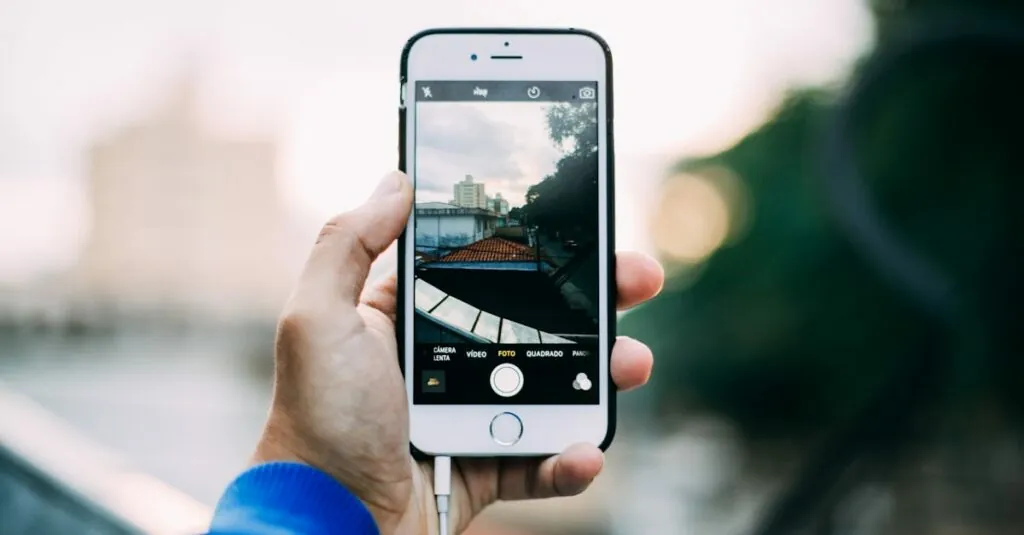Table of Contents
ToggleIn a world where photos are the currency of social media, knowing how to save images as JPEGs on an iPhone can be a game changer. Whether you’re trying to impress your friends with stunning vacation snaps or simply want to free up some storage space, mastering this skill is essential. After all, who wants to deal with the hassle of incompatible formats when they could be sharing their best moments instead?
Understanding JPEG Format
JPEG, short for Joint Photographic Experts Group, serves as a widely used image format. It optimizes storage without sacrificing significant quality. This makes JPEG ideal for photos on social media platforms. Devices and applications frequently support this format, ensuring compatibility across various systems.
Quality compression is a key feature of JPEGs. It allows users to reduce file sizes while maintaining acceptable image clarity. This balance between quality and size benefits individuals with limited storage space on devices. Digital cameras and smartphones often capture images in JPEG format, making it the default choice for many.
Another characteristic of JPEG files is their ability to support millions of colors. This broad color range results in vibrant and rich images. Users frequently notice improved detail and depth, enhancing their viewing experience. JPEG compression employs lossy techniques, meaning some data may be lost during saving, which is a trade-off for smaller file sizes.
When saving images, understanding the limitations of JPEG is crucial. While it handles photographs well, it may not perform optimally with graphics or images containing sharp edges. Such details tend to blur, compromising clarity. Choosing the right format for the task ensures better results.
For anyone interested in sharing images, JPEG remains the standard format. Its ease of use and compatibility underscore its importance. Managing photo collections becomes more straightforward when using JPEG, making it a preferred choice for storing memories on iPhones. Savvy users take advantage of these benefits to improve their overall photo experience.
Why Save Photos as JPEG?
JPEG is a preferred format for saving photos on iPhones due to several key advantages. This format efficiently balances image quality and file size, making it ideal for sharing online.
Benefits of JPEG
JPEG files provide smaller sizes compared to other formats, allowing users to store more images on their devices. The compression also enables easier sharing across social media platforms and faster uploads. Image clarity often remains high, even at lower file sizes, ensuring vibrant colors and detail in photos. Additionally, JPEG is universally compatible, which means it can be opened on most devices and applications without issues. These benefits result in a straightforward photo management experience, making JPEG an optimal choice for everyday use.
When to Use JPEG
JPEG suits various scenarios, especially when sharing images on social media or via messaging apps. This format excels for casual photography, like family gatherings or vacations, where vibrant colors matter. Users should choose JPEG for images that will be displayed online or printed in standard formats. If maintaining full detail and resolution isn’t a priority, JPEG works perfectly. In contrast, situations requiring high-quality images, such as professional photography, may benefit from other formats like TIFF or RAW.
How to Save Photo on iPhone as JPEG
Saving photos as JPEG on an iPhone is simple and enhances sharing options. Follow these methods to save and manage images effectively.
Using the Photos App
To save a photo as JPEG using the Photos app, first select the desired image. Tap the share icon, then choose “Save to Files.” From there, select the JPEG format option before confirming the save location. This approach ensures the image retains high quality while optimizing storage space. Check your files afterward to confirm the successful conversion.
Using Third-Party Apps
For those seeking additional features, third-party apps offer flexible options for saving photos as JPEG. Download a reliable photo converter app, then open the image within the application. Most apps have a dedicated option to save or export as JPEG. Select this option, adjust any necessary settings, then save the image back to your library. These apps often provide advanced options that enhance image quality and optimize for specific uses.
Troubleshooting Common Issues
Users often encounter various issues when saving photos as JPEGs on an iPhone. Understanding these problems can simplify the process.
Photo Quality Concerns
Photo quality plays a significant role when saving images. JPEGs might exhibit some loss of detail, especially if images contain sharp edges or intricate details. Users notice this effect when they zoom in on photos taken in such situations. Adjusting the compression settings on certain apps can mitigate quality loss. Using apps that allow users to customize export settings enhances image clarity. It’s essential to check the final output to ensure it meets personal standards.
File Size Management
Managing file size can become crucial for iPhone users with limited storage. JPEGs offer excellent compression, but excessive compression can lead to noticeable quality deterioration. Choosing the right balance between quality and size is vital. Users can monitor file sizes when exporting images through various apps. Identifying large files can help in managing storage effectively. Regularly removing unwanted photos also assists in maintaining available space on the device.
Saving photos as JPEGs on an iPhone is a valuable skill that enhances the user experience. It simplifies sharing vibrant images across social media while effectively managing storage space. By understanding the JPEG format and its benefits users can ensure their photos maintain quality without taking up excessive space.
Utilizing the built-in Photos app or third-party applications provides flexibility in how images are saved. With a few simple steps users can optimize their photo management and enjoy a seamless experience. Regularly monitoring storage and adjusting settings will further enhance their ability to capture and share memorable moments. Embracing this knowledge empowers users to make the most of their iPhone photography.





